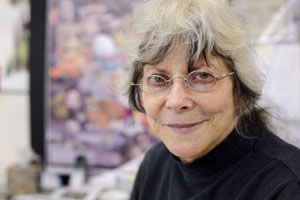UW-Madison artist wins international visualization challenge
Watch yourself around Kandis Elliot’s art, because it may be smuggling things into your brain.

Kandis Elliot, senior artist in the Department of Botany, is pictured in her Birge Hall office.
Photo: Jeff Miller
“It’s a lot easier to learn the science in little bits,” says Elliot, senior artist in the Department of Botany. “So we sneak in a little education with the pretty pictures.”
It’s hard to be sneaky all the time, though.
The journal Science caught Elliot and Botany Greenhouse Director Mo Fayyaz quietly educating people, awarding them first place for informational graphics in their 2010 International Science & Engineering Visualization Challenge for their “Introduction to Fungi” poster.
They may have won on sheer volume.
“It’s 25 pounds of mushrooms on a five-pound poster,” says Elliot, who took about three months putting together the winning entry. “And it looks like gobs of information, but it’s really the bare minimum we could say.”
For more than two decades, Elliot has been cranking out posters and graphics, and digitizing samples new and historical for botanists, but her original plan was zoology. That is until, after finishing her master’s degree at UW–Madison, Elliot grew concerned animal research was not her cup of tea.
“Introduction to Fungi,” a detailed poster by Kandis Elliot won the 2010 International Science and Engineering Visualization Challenge, an award program sponsored by the National Science Foundation and the journal Science. View a larger version.
After studying applied art at Madison Area Technical College — “I was always one of those kids who could draw,” she says — and working freelance, Elliot’s old grad school friends tipped her to an opening in Botany’s artist chair. It was 1988, and she impressed the interview panel by describing the speed and quality of computer-based graphic design.
That’s not to say that she was necessarily well-acquainted with the software in a firsthand way.
“I went down to DoIT, where I knew they were playing with Apple computers,” Elliot says. “I walked in, held up a $100 bill and said, ‘Who can teach me this stuff?’ Some kid came up, snatched the bill and I was on my way.”
It worked. Freed from using straight edges, T-squares and press-on letters and numbers, Elliot started turning around chart and graph assignments in a day instead of weeks. It left her time for other projects — melding her feel for science with her flair for art in an environment rich with inspiration.
“When you talk to faculty, it’s just endless information. They just know all these tidbits about everything,” she says. “I listen, and I think, ‘Why aren’t we using this?’ This isn’t taught in class to more than a few botany students. If it’s written down, it’s in journals just for other scientists. How do we get it in people’s hands?”
Elliot has illustrated books for the UW Arboretum, her own science fiction stories in Asimov magazine (often based on UW–Madison research or myths such as Birge’s cockroach infestation), NASA space stations and moon bases, and even material from those journals for other scientists.
“She’s done artistic illustrations that describe some very complicated ideas,” says Linda Graham, a botany professor who enlisted Elliot to help get across information gleaned from massive eons-old fossils. “We used a lot of math, modeling and microscopy. Kandis translated all of that information into a snapshot that a time traveler might take if they go back hundreds of millions of years.”
It was Graham who talked Elliot into entering the Visualization Challenge, but Fayyaz who provided a great deal of the information for the botanical poster series — which is available for purchase from the botany department and popular in classrooms full of students from young ages up through college.
“She’s like a great cook,” Fayyaz says. “I give her the raw materials and leave her alone, and when I come back, it’s art.
“You could give the same ingredients to a lot of other people and when they’re done, you just want to throw it in the garbage,” he adds.
Even garbage has its place in a Kandis Elliot poster. “Introduction to Fungi” walks you through the dizzying taxonomy — past lichens and mushrooms and the fungus causing white-nose syndrome threatening bats — to brewer’s and baker’s yeast and the moldy fruit left on the kitchen counter.
“These are my squashes that went bad, my moldy peach, my moldy orange,” Elliot says, pointing out the more common fungi on the winning poster. “My contribution to science.”
The posters are a mixture of photography and painting, but it’s hard to tell which is which.
“Well, that’s the idea,” Elliot adds.
Hiding the brushstrokes is key to another Elliot contribution. She and media specialist Sarah Friedrich carefully make “plates” — graphic representations of new specimens in the department’s collections — as well as digitize some of the remarkable, but very fragile, plates made decades ago.
“Archiving the images that were created a long time ago and are beginning to crumble — in a form that can be retrieved later without repeating a lot of work — is so important to the future of our science,” Graham says. “I was happy to see Kandis get some recognition, because the quality of her work and the impact it can have is something we know very well here.”
See more posters from the botanical series at http://www.botany.wisc.edu/art/pages/posters.html, and more of Elliot’s work at http://www.botany.wisc.edu/art/index.html.





